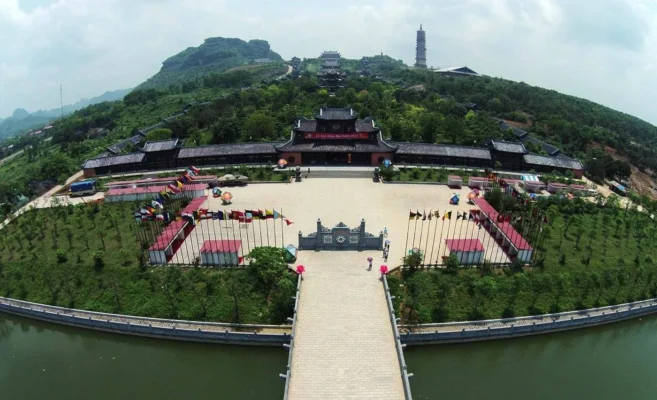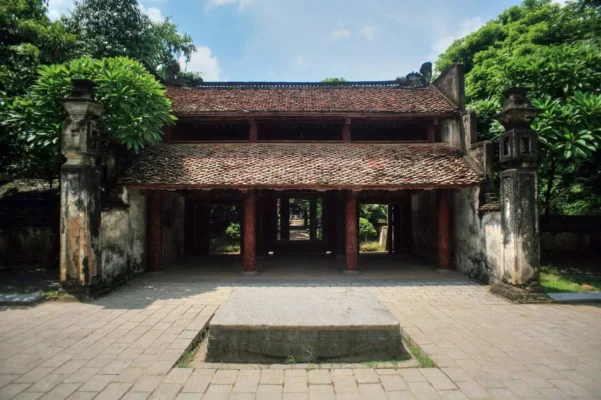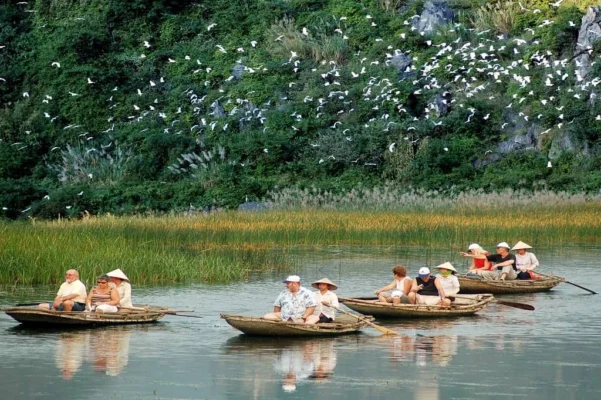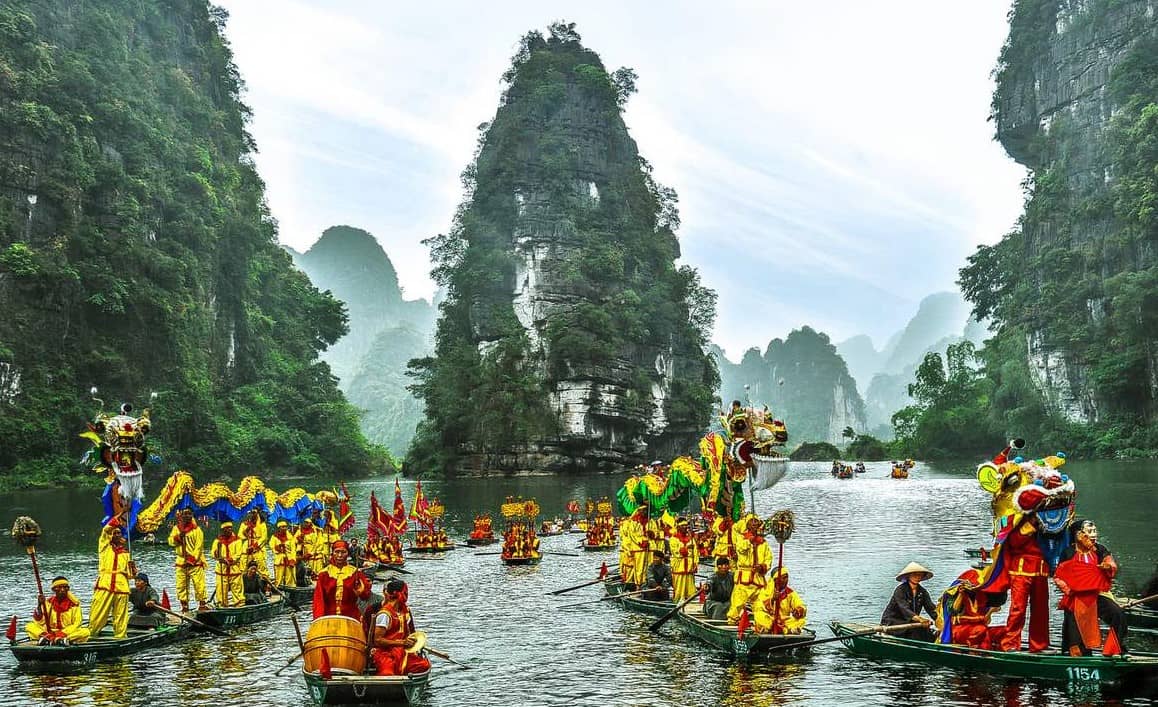
Let’s go back in time to the Hoa Lu ancient capital
Discover Hoa Lu Ancient Capital, the historic heart of Vietnam, located in Ninh Binh province. Explore the ancient temples of the Dinh and Le dynasties, including the temples of King Dinh Tien Hoang and King Le Dai Hanh. Marvel at the remnants of the old city walls and immerse yourself in the stunning natural landscapes of limestone peaks and serene rivers. Plan your visit with Ula Travel to this UNESCO-recognized site for a journey through Vietnam’s rich history and breathtaking scenery.
I. Introduction to the Hoa Lu Ancient Capital
1. Where is Hoa Lu Ancient Capital?
Hoa Lu Ancient Capital is located in Ninh Binh Province, in the northern part of Vietnam. Situated approximately 96 kilometers south of Hanoi, Hoa Lu Ancient Capital is nestled within a region known for its stunning limestone karst landscapes and scenic beauty. The ancient capital is positioned in a valley surrounded by dramatic peaks and lush greenery, making it an ideal location for visitors interested in both history and nature.
- Address: Truong Yen Commune, Hoa Lu District, Ninh Binh Province, Vietnam
- Entrance fee: 20,000 VND for each person
- Opening hours: 7 a.m. to 5 p.m.
2. History of Hoa Lu Ancient Capital

Hoa Lu was the ancient capital of two dynasties in Vietnamese history.
Hoa Lu Ancient Capital holds a special place in Vietnamese history as it served as the country’s capital during the 10th and 11th centuries under the Đinh and Lê dynasties. This period marked a pivotal moment in Vietnam’s history as the nation established its sovereignty and began to develop its cultural and political identity.
- Đinh Dynasty (968–980): Hoa Lu became the capital under Emperor Đinh Tiên Hoàng, who is credited with founding the Đinh Dynasty and consolidating the nation after a long period of internal strife and foreign invasions. The Đinh Dynasty was instrumental in laying the groundwork for Vietnam’s centralized state and governance.
- Lê Dynasty (980–1009): Following the Đinh Dynasty, Hoa Lu continued to serve as the capital under the Lê Dynasty, with Emperor Lê Đại Hành succeeding the Đinh rulers. The Lê Dynasty is renowned for its efforts to stabilize and expand the empire, as well as for its contributions to the cultural and architectural development of the period.
Hoa Lu Ancient Capital’s strategic location and its role as the political center during these formative centuries made it a symbol of national unity and strength. The remnants of its ancient architecture, including temples, palaces, and fortifications, reflect its historical significance and continue to attract historians, scholars, and tourists. The site is also a testament to Vietnam’s rich cultural heritage and its enduring legacy as a historical capital.
II. Major Attractions in Hoa Lu Ancient Capital
1. Hoa Lu Ancient Capital

Hoa Lu Ancient Capital is a testament to a time of brilliant development.
Hoa Lu Ancient Capital is a historical treasure trove that offers a glimpse into the grandeur of the Dinh and Le dynasties. Established as the capital of Vietnam during the 10th and 11th centuries, Hoa Lu Ancient Capital played a pivotal role in the nation’s history. Today, it stands as a significant archaeological and cultural site, showcasing the architectural and artistic achievements of its time.
- Historical Significance: As the capital city of the Dinh Dynasty founded by Emperor Dinh Tien Hoang and later the Le Dynasty under Emperor Le Dai Hanh, Hoa Lu was strategically located in a natural fortress of limestone mountains and lush valleys. The ancient city’s layout reflects sophisticated urban planning and defensive architecture.
- Architectural Highlights: Visitors can explore the remains of royal palaces, temples, and defensive walls that highlight the city’s historical importance. The preservation of these structures provides valuable insights into Vietnam’s feudal era.
Start your journey with Ninh Binh Tour in 2 Days.
2. Dinh Tien Hoang Temple

Dinh Tien Hoang Temple
- Historical Significance: Dedicated to King Dinh Tien Hoang, the founder of the Dinh Dynasty, this temple is one of the most revered sites in Hoa Lu. King Dinh Tien Hoang established the Dinh Dynasty in 968 and made Hoa Lu the capital. His reign marked the beginning of the Vietnamese feudal state.
- Architecture: The temple features traditional Vietnamese architectural styles with intricate wooden carvings and detailed sculptures. The main hall is adorned with a statue of King Dinh Tien Hoang, surrounded by offerings and incense, reflecting the deep respect for the king.
- Cultural Importance: Visiting this temple offers insight into the early political history of Vietnam and the legacy of King Dinh Tien Hoang. The temple is a focal point for various cultural and religious ceremonies, especially during the annual Dinh Temple Festival.
Click here: Hanoi to Ninh Binh in 3 Days
3. Le Dai Hanh Temple

Le Dai Hanh Temple
- Historical Significance: This temple is dedicated to King Le Dai Hanh, who succeeded King Dinh Tien Hoang and established the Le Dynasty. His reign began in 980 and was notable for consolidating and expanding the power of the Vietnamese state.
- Architecture: The Le Dai Hanh Temple is known for its classical design, with a serene and spacious courtyard leading to the main hall. The temple’s structure is characterized by traditional wooden beams and tiled roofs, creating an aura of ancient grandeur.
- Cultural Importance: The temple serves as a tribute to King Le Dai Hanh’s contributions to Vietnamese history. It is a place where visitors can learn about the political and military strategies employed by King Le Dai Hanh to defend the country from external threats and strengthen the Vietnamese state.
You will be like: Discover Ninh Binh Day Trip from Hanoi for Best Experiences
4. Ancient City Walls and Gates

Ancient city gate
- Historical Significance: The ancient city walls and gates of Hoa Lu Ancient Capital are remnants of the city’s original fortifications. These walls were crucial in protecting the capital from invasions and attacks during the Dinh and Le Dynasties.
- Architecture: The surviving portions of the city walls are built from large stone blocks and are interspersed with ancient gates that once served as the main entry points to the city. These structures reflect the advanced military engineering of the time.
- Cultural Importance: Exploring the ancient city walls provides a tangible connection to the past and offers a glimpse into the strategic defense mechanisms employed to safeguard the capital. The walls also highlight the architectural and engineering prowess of the era.
III. Best Time to Visit Hoa Lu Ancient Capital
The Hoa Lu Ancient Capital is renowned for its unique festivals commemorating the kings, who played a significant role in establishing and defending the country in ancient times. To have the most meaningful experiences, you should visit Hoa Lu Ancient Capital during the dry season rather than during the heavy rainy seasons. Specifically, the best times to visit are:
- Early Spring: After the Lunar New Year, the people of Hoa Lu, Ninh Binh, organize numerous traditional festivals that you shouldn’t miss, such as the Bao Ban Non Khe Festival and the Den La Festival.
- May: Not only is the weather pleasant, but late May is also the season of ripe rice in Ninh Binh. This is the perfect time to admire the stunning beauty of the golden rice fields, especially when combined with visits to other attractions like Tam Coc and Hang Mua.
- March: This is when the Truong Yen Festival, also known as the Co Lau Festival, takes place. It is one of the most famous traditional festivals of the Hoa Lu Ancient Capital and is held annually from the 8th to the 10th day of the third lunar month.
Do not miss: Festivals in Ninh Binh
IV. How to Get to Hoa Lu Ancient Capital
From Hanoi’s city center, you need to travel approximately 96 kilometers to reach the Hoa Lu Ancient Capital. If you’re starting from Ninh Binh’s city center, the distance is only about 15 kilometers. Here are the transportation options available for traveling from Hanoi to Ninh Binh:
- Motorbike: This is a suitable option if you have good stamina and want to explore the sunny and windy routes on your own. It takes about 1.5 hours to reach the ancient capital of Hoa Lu by motorbike.
- Bus or Limousine: The second most popular mode of transportation is the bus. You can catch a bus from Giap Bat or My Dinh stations, with a travel time of around 60 minutes. After arriving in Ninh Binh city center, you’ll need to take a motorbike taxi or regular taxi to reach the Hoa Lu Ancient Capital.
- Car: The driving distance is approximately 100 kilometers (62 miles). The travel time is about 2 hours.
- Bus: Buses to Ninh Bình depart from several locations in Hanoi, including the Giap Bat Bus Station and the My Dinh Bus Station. Travel time is approximately 2.5 to 3 hours.
- Train: Trains from Hanoi to Ninh Bình leave from Hanoi Railway Station. The travel time is approximately 2 to 2.5 hours. Trains offer a comfortable journey and scenic views. From Ninh Bình Railway Station, you can take a taxi or local transportation to Hoa Lu Ancient Capital.
V. What to eat in the Hoa Lu Ancient Capital
1. Goat Meat

Ninh Binh goat meat specialty
Mountain goat from Ninh Binh is a must-try specialty. The goat meat is prepared in various delicious dishes, such as grilled goat, goat with lime, steamed goat, goat spring rolls, goat blood pudding, and goat porridge. These dishes are not only flavorful but also extremely nutritious.
Click here: Ninh Binh to Halong Bay – Heritage Road Journey 4D3N
2. Crispy Rice

Cơm Cháy
This is a famous dish from the ancient capital area, with a long history. Made from familiar ingredients and crafted by skilled hands, crispy rice has become a highly appealing local specialty.
The local people often enjoy crispy rice with mountain goat sauce, which is made from the meat of mountain goats and has a rich, savory flavor. During your trip to Ninh Binh, you can visit restaurants such as Thung Nham Restaurant, Chính Thư, or Tụng Dung to enjoy this dish and buy some to take home as souvenirs for family and friends.
3. Nhech Fish Salad

Nhech Fish Salad
Nhech fish, resembling a long, slimy eel, typically live in brackish and freshwater. Kim Son in Ninh Binh is renowned for having the best nhech fish salad in the northern region. Preparing nhech fish salad is a meticulous process: the fish is salted or scrubbed to remove its slimy skin, then the blood is drained, the belly is cleaned, and the meat is separated from the bones. The fish meat is mixed with special seasonings to preserve its flavor and sweetness.
Learn more about: Ninh Binh Cuisine
VI. Nearby Attractions
When exploring the Hoa Lu Ancient Capital, you’ll find several captivating attractions in the vicinity that are worth adding to your itinerary. Here’s a detailed guide to some of the must-visit nearby spots:
1. Tam Coc

Tam Coc
Often referred to as “Halong Bay on Land,” Tam Coc is a stunning natural wonder located about 10 kilometers from Hoa Lu Ancient Capital. The area is renowned for its dramatic limestone karsts and picturesque landscapes.
Visitors can enjoy a serene boat ride along the Ngo Dong River, passing through lush rice fields and spectacular cave formations, including the famous Hang Ca, Hang Hai, and Hang Ba caves. The boat trips offer a unique view of the surrounding countryside and are a great way to experience the tranquil beauty of the region.
2. Bich Dong Pagoda

Bich Dong Pagoda
Situated around 12 kilometers from Hoa Lu Ancient Capital, Bich Dong Pagoda is a beautiful complex nestled into the side of a limestone mountain. The pagoda, known as the “Blue Pearl Pagoda,” is renowned for its stunning architecture and serene setting.
The complex consists of three tiers: the lower pagoda, the middle pagoda, and the upper pagoda. Each level offers a different perspective of the surrounding landscape and provides a peaceful retreat for meditation and reflection.
Learn more about: Northern Vietnam Itinerary
3. Trang An Scenic Landscape Complex

Trang An Scenic Landscape Complex
Approximately 15 kilometers from Hoa Lu Ancient Capital, the Trang An Scenic Landscape Complex is a UNESCO World Heritage Site celebrated for its natural beauty and historical significance. This area is characterized by its impressive karst landscapes, winding rivers, and ancient temples.
Visitors can take a scenic boat tour through the waterways, exploring the intricate system of caves and grottoes that weave through the dramatic limestone formations. Trang An is also home to several historical sites, including ancient pagodas and temples that add a cultural dimension to the natural splendor.
Do not miss: Things to do in Ninh Binh
4. Van Long Nature Reserve

Van Long Nature Reserve
Located about 25 kilometers from Hoa Lu Ancient Capital, Van Long Nature Reserve is known for its stunning wetland landscapes and rich biodiversity. The reserve is an excellent spot for birdwatching, with many rare and migratory species inhabiting the area. Visitors can take boat rides through the tranquil waters, explore the scenic wetlands, and enjoy views of the majestic limestone peaks that surround the reserve.
5. Hang Mua (Mua Cave)

Hang Mua
Hang Mua, also known as Mua Cave, is one of the most stunning natural attractions near Hoa Lu Ancient Capital. Situated in Ninh Bình Province, this site is renowned for its dramatic landscapes and panoramic views. The cave itself is nestled at the foot of Múa Mountain, which rises majestically above the lush rice fields and limestone karsts of the area.
A highlight of Hang Múa is the breathtaking viewpoint that can be reached by climbing approximately 500 stone steps. From the top, visitors are rewarded with a sweeping vista of the surrounding landscape, including the Tam Coc area and the lush green fields.
6. Tuyet Tinh Coc (Tuyet Tinh Valley)

Tuyet Tinh Valley
Tuyet Tinh Coc, also known as Tuyet Tinh Valley, is a serene and picturesque destination located not far from Hoa Lu Ancient Capital. This attraction is known for its tranquil lakes, lush greenery, and dramatic limestone formations, creating a perfect escape from the hustle and bustle of everyday life.
The valley is characterized by its calm, reflective lakes, surrounded by verdant hills and striking limestone cliffs. The scenery is reminiscent of scenes from traditional Vietnamese landscape paintings, offering a peaceful and idyllic environment.
In summary, Hoa Lu Ancient Capital is a must-visit destination for international travelers seeking to explore Vietnam’s rich history and stunning natural beauty. As the former capital during the Đinh and Lê dynasties, Hoa Lu Ancient Capital offers fascinating historical sites like the Đinh Tiên Hoàng and Lê Đại Hành temples, set against a backdrop of striking limestone landscapes.
Its blend of cultural significance and scenic charm provides a unique experience that captures the essence of Vietnam’s heritage. A visit to the Hoa Lu Ancient Capital not only enriches your understanding of the past but also offers a serene escape into nature, making it a memorable addition to any travel itinerary.
See more: Ninh Binh Travel Tips



























